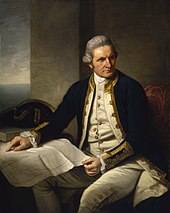Royal Navy ranks, rates, and uniforms of the 18th and 19th centuries
Coats were often dark blue to reduce fading caused by the rain and spray, with gold embroidery on the cuffs and standing collar to signify the officer's wealth and status.
[citation needed] Over time, the nautical command structure merged these two separate command chains into a single entity with captain and lieutenant as commissioned officer ranks while sailing master (often shortened to simply "master") was seen as a type of warrant officer specializing in navigation and ship handling.
In 1856, Royal Navy officer insignia shifted to the use of rank sleeve stripes – a pattern which has endured to the present day.
Warrant officers had rights to mess and berth in the wardroom and were normally considered gentlemen; however, the Sailing Master was often a former sailor who had "come through the ranks" therefore might have been viewed as a social unequal.
[3] Next came the ship's three "standing officers", the Carpenter, Gunner and Boatswain (Bo'sun), who along with the master were permanently assigned to a vessel for maintenance, repair, and upkeep.
[4][5] Boys aspiring for a commission were often called young gentlemen instead of their substantive rating to distinguish their higher social standing from the ordinary sailors.
[7][N 1] The remainder of the ship's company, who lived and berthed in the common crew quarters, were the petty officers and seamen.
This rating set the petty officers apart from the common seaman by virtue of technical skill and slightly higher education.
No special uniform was allocated for petty officers, although some Royal Navy ships allowed such persons to don a simple blue frock coat to denote their status.
Grouped among the watches were also the landsmen, considered the absolute lowest rank in the Royal Navy and assigned to personnel, usually from press gangs, who held little to no naval experience.
[citation needed] Enlisted seamen and marines discharged due to disability or advanced age could be admitted to the Royal Hospital, Greenwich.
[11] From the ages of five or six, farmers' children would assist with the sowing and gathering crops while a chimney sweep's climbing boy might be as young as three or four.
[12][13] The view that child labour was both morally and legally acceptable was prevalent not just in Britain but throughout the world's most advanced nations.
[15][16] This was a popular and recognised route, offering an opportunity to accumulate knowledge and sea time, prior to becoming a midshipman.
Service as a ship's boy was recorded as sea-service; officers' servants could obtain credit towards the mandatory six years of sea time needed before attempting the lieutenant's exam.
[17] It was not uncommon for these boys to be signed on in name only while they remained on land at school, high-ranking officers supplying fictitious seatime in exchange for some reward or favour.
[19] The Marine Society, founded in 1756 by Jonas Hanway, was a charity that encouraged poor and destitute young boys to seek a better life in the navy.
[citation needed] Promotion and advancement within the 18th and 19th century Royal Navy varied depending on the status of the sailor in question.
At the lower levels, most inexperienced sailors began in the rank of landsman – those joining ships at a very young age were typically entered in the navy as cabin boys or officers' servants.
Advancement into the commissioned officer grades required a royal appointment, following a certification by the lieutenant's examination board.
[citation needed] The title of commander was originally[21] a temporary position for lieutenants placed in charge of smaller vessels.
Any other person on board who did not stand watch was collective referred to as an "idler" but was still subject to muster when the "all hands on deck" was called by the boatswain.
[citation needed] In addition to the standard watch organisation of a Royal Navy vessel, additional organisational hierarchies included the division, headed by a lieutenant or midshipman, mainly to muster, mess, and berth; divisions were typically present only on the larger rated vessels.
[citation needed] The term "Action Stations" was a battle condition in which a Royal Navy vessel manned all of its guns with gun crews, stood up damage control and emergency medical teams, and called the ship's senior officers to the quarterdeck in order to direct the ship in battle.
This year also saw Warrant officers (Masters, Surgeons, Pursers, Boatswains, and Carpenters) being granted a standardised, plain blue uniform as well.
[citation needed] Surgeons, who had hitherto worn the standard warrant officer's uniform, were, in June 1805, given waistcoat and breeches, a blue, single-breasted coat with white lining, standing collar and eight buttons for dress occasions.
Instead of sloping away from the chest, the tails of the coat were now cut away at the waist (like a modern-day civilian tailcoat) and were ordered to be buttoned up at all times.
[citation needed] Flag rank advancement in the 18th and 19th century Royal Navy was determined entirely by seniority.
[citation needed] As further vacancies occurred, the British flag officer would be posted to the same rank in higher squadrons.
Such was the case with William Bligh, who was promoted directly from rear admiral to vice-admiral of the blue without ever having served as a rear-admiral of the red or white squadron.


















